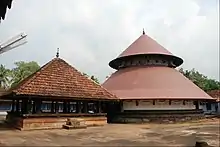Goda Ravi
Goda Ravi (fl. c. 905–c. 943 AD[1]) was a Chera Perumal king of medieval Kerala, south India.[2] An inscription mentioning Goda Ravi from Nedumpuram Thali, Wadakkanchery (929-30 AD) is one of rare Chera Perumal inscriptions which give both the regnal year and another era (Kali Era or Kollam Era) at the same time.[2] The Koyil or the Royal Prince during the time of Goda Ravi was certain Ravi Aditya (who was also a minister).[3]
| Goda Ravi | |
|---|---|
| Ruler of Chera Perumal Kingdom | |
| Reign | c. 905–c. 943 AD |
| Predecessor | Goda Goda (or) Kerala Kesari |
| Successor | Indu Goda |
| House | Chera Perumals of Makotai |
| Religion | Hinduism |
The Chola relations with the Chera Perumals were consolidated during the rule of Goda Ravi. Vellan Kumaran, son of the chieftain of Valluvanad, and other nobles from Kerala, are known to served under Chola prince Rajaditya.[4] Temple inscriptions dated in the regnal years (15th to 30th) of Goda Ravi were discovered from Chokkur (Puthur village, near Koduvally), Nedumpuram Thali (Wadakkanchery), Avittathur, Tripparangode, Poranghattiri, Indianur (Kottakkal) and Thrippunithura.[2] The records mention, among other things, certain Cheraman Maha Devi (the Chera queen), the so-called Agreement of Muzhikkulam, and the chieftains of Vembanadu (Alappuzha) and Valluvanad (the later with the title 'Rayira Ravar').[2]
Goda Ravi was formerly identified with king Vijayaraga of the Chera Perumal dynasty.[2][1]
Coronation year
Recent scholarship suggests that the regnal year and the Kali Era, mentioned at the same time, may not be the same actual year.[1]
| Regnal Year
(Slab I) |
Kali Era Reading
(Slab II) |
Corresponding Dates | Jupiter in Mithuna | Coronation Year | Presently
accepted | |
|---|---|---|---|---|---|---|
| A. G. Warrier | Regnal Year 17 | 'nālāyirattumuppata'
('4030') |
929 AD | Does not agree with the position of Jupiter |
912 AD | |
| Elamkulam P. N. K. Pillai | 'nālāyirattumuppat[tancu].'
('4035') |
934 AD | Agree with the position of Jupiter |
917 AD | ||
| M. G. S. Narayanan | 'nālāyirattumoppata'
('done in 4000') |
900 AD | 883 AD | |||
| Present view | 'nālāyirattumuppata'
('4030') = 929 AD |
|
905 AD |
Epigraphic records


Note: Material: granite, script: Vattezhuthu with Grantha characters, and language: old Malayalam (unless otherwise stated)
| Year | Regnal Year | Location | Contents | |||
|---|---|---|---|---|---|---|
| Nature | Notes | |||||
| 920 AD | 15 | Chokkur inscription (Chokoor, Puthur village) - near Koduvally - single granite slab in courtyard of the ruined Chokkur Temple. | Temple inscription
(by founder) |
|||
| 922 AD | 17 | Nedumpuram Thali inscription, Thichoor Wadakkanchery
(Thali inscriptions of Cochin State) - two granite slabs fixed into the half wall in the entrance corridor on the left side of Nedumpuram Thali. |
Temple committee resolutions | Dated in Kali Year 4030 (=929/30 AD).[1] | ||
| 925 AD | 20 | Avittathur inscription I - single granite slab paved in the courtyard of the Avittathur Temple near the sopana. | Temple committee resolutions | |||
| Avittathur inscription II - single granite slab paved in the courtyard of the Avittathur Temple to the right of the srikoyil (a few feet away from sopana). | Temple committee resolutions | Council is attended by the chieftain of Valluvanad (the Rayira Ravar).[3] | ||||
| Avittathur inscription III - single granite slab paved in the courtyard of the Avittathur Temple (a few feet away from sopana). | Temple committee resolutions | Council is attended by the chieftain of Valluvanad (the Rayira Ravar).[3] | ||||
| 932 AD | 27 | Tripparangode inscription (originally in Sri Krishna shrine, Tripparangode Shiva Temple) - Triprangode- now in Archeological Museum, Trichur. | Temple committee resolutions |
| ||
| Poranghattiri inscription (Chaliyar) - single granite slab in the courtyard of the Poranghattiri Temple. | Temple committee resolutions | |||||
| Indianur inscription (Kottakkal) - originally at Indianur Temple - now in Department of History, Calicut University. | Temple committee resolutions | |||||
| 935 AD | 30 | Thrippunithura inscription (originally from Santhana Gopalakrishna Temple, Thrippunithura) - now in Archeological Museum, Trichur. | Temple committee resolutions | |||
References
- 'Changes in Land Relations during the Decline of the Cera State,' In Kesavan Veluthat and Donald R. Davis Jr. (eds), Irreverent History: Essays for M.G.S. Narayanan, Primus Books, New Delhi, 2014. 74-75.
- Narayanan, M. G. S. Perumals of Kerala: Brahmin Oligarchy and Ritual Monarchy Thrissur (Kerala): CosmoBooks, 2013. 65-67.
- Narayanan, M. G. S. Perumals of Kerala: Brahmin Oligarchy and Ritual Monarchy Perumāḷs of Kerala. Thrissur (Kerala): CosmoBooks, 2013. 438-42.
- Ali, Daud (2017). "The Death of a Friend: Companionship, Loyalty and Affiliation in Chola South India:". Studies in History. doi:10.1177/0257643016677455.